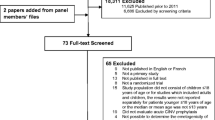Abstract
Purpose
This clinical trial was conducted to evaluate the efficacy and safety of Palonosetron in preventing chemotherapy-induced vomiting (CIV) among the Chinese cancer patients.
Patients and methods
Two hundred and forty patients were scheduled to be enrolled and randomized to receive a single intravenous dose of palonosetron 0.25 mg, or granisetron 3 mg, 30 min before receiving highly emetogenic chemotherapy. The primary efficacy endpoint was the complete response (CR) rate for acute CIV (during the 0–24-h interval after chemotherapy). Secondary endpoints included the CR rates for delayed CIV (more than 24 h after chemotherapy).
Results
Two hundred and eight patients were accrued and received study medication. CR rates for acute CIV were 82.69% for palonosetron and 72.12% for granisetron, which demonstrated that palonosetron was not inferior to granisetron in preventing acute CIV. Comparisons of CR rates for delayed CIV yielded no statistical difference between palonosetron and granisetron groups and did not reveal non-inferiority of palonosetron to granisetron. Adverse events were mostly mild to moderate, with quite low rates among the two groups.
Conclusions
A single dose (0.25 mg) of palonosetron is not inferior to a single dose (3 mg) of granisetron in preventing CIV and possesses an acceptable safety profile in the Chinese population.
Similar content being viewed by others
References
Stoltz R, Cyong JC, Shah A, Parisi S (2004) Pharmacokinetic and safety evaluation of palonosetron, a 5-hydroxytryptamine-3 receptor antagonist, in U.S. and Japanese healthy subjects. J Clin Pharmacol 44(5):520–531 May
Abali H, Celik I (2007) Tropisetron, ondansetron, and granisetron for control of chemotherapy-induced emesis in Turkish cancer patients: a comparison of efficacy, side-effect profile, and cost. Cancer Invest 25(3):135–139 Apr, May
Fleming TR (2008) Current issues in non-inferiority trials. Stat Med 27(3):317–332 Feb 10
Hesketh PJ (2000) Comparative review of 5-HT3 receptor antagonists in the treatment of acute chemotherapy-induced nausea and vomiting. Cancer Invest 18:163–173
Aapro MS, Grunberg SM, Manikhas GM, Olivares G, Suarez T, Tjulandin SA, Bertoli LF, Yunus F, Morrica B, Lordick F, Macciocchi A (2006) A phase III, double-blind, randomized trial of palonosetron compared with ondansetron in preventing chemotherapy-induced nausea and vomiting following highly emetogenic chemotherapy. Ann Oncol 17:1441–1449
Eisenberg P, Figueroa-Vadillo J, Zamora R, Charu V, Hajdenberg J, Cartmell A, Macciocchi A, Grunberg S, 99–04 Palonosetron Study Group (2003) Improved prevention of moderately emetogenic chemotherapy-induced nausea and vomiting with palonosetron, a pharmacologically novel 5-HT3 receptor antagonist: results of a phase III, single-dose trial versus dolasetron. Cancer 98:2473–2482
Eisenberg P, MacKintosh FR, Ritch P, Cornett PA, Macciocchi A (2004) Efficacy, safety and pharmacokinetics of palonosetron in patients receiving highly emetogenic cisplatin-based chemotherapy: a dose-ranging clinical study. Ann Oncol 15(2):330–337 Feb
Grote T, Hajdenberg J, Cartmell A, Ferguson S, Ginkel A, Charu V (2006) Combination therapy for chemotherapy-induced nausea and vomiting in patients receiving moderately emetogenic chemotherapy: palonosetron, dexamethasone, and aprepitant. J Support Oncol 4(8):403–408 Sep
Oo TH, Hesketh PJ (2005) Drug insight: New antiemetics in the management of chemotherapy-induced nausea and vomiting. Nat Clin Pract Oncol 2(4):196–201 Apr
Kaizer L, Warr D, Hoskins P et al (1994) Effect of schedule and maintenance on the antiemetic efficacy of ondansetron combined with dexamethasone in acute and delayed nausea and emesis in patients receiving moderately emetogenic chemotherapy: a Phase III trial by the National Cancer Institute of Canada Clinical Trials Group. J Clin Oncol 12:1050–1057
Siddiqui MA, Scott LJ (2004) Palonosetron. Drugs 64(10):1125–32 discussion 1133–1134
Author information
Authors and Affiliations
Corresponding author
Rights and permissions
About this article
Cite this article
Yu, Z., Liu, W., Wang, L. et al. The efficacy and safety of palonosetron compared with granisetron in preventing highly emetogenic chemotherapy-induced vomiting in the Chinese cancer patients: a phase II, multicenter, randomized, double-blind, parallel, comparative clinical trial. Support Care Cancer 17, 99–102 (2009). https://doi.org/10.1007/s00520-008-0503-4
Received:
Accepted:
Published:
Issue Date:
DOI: https://doi.org/10.1007/s00520-008-0503-4




